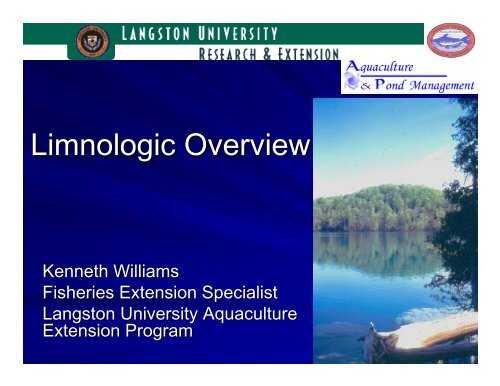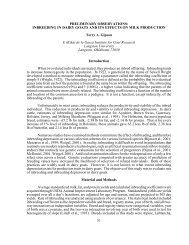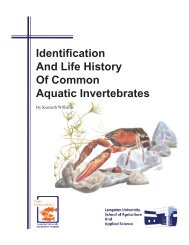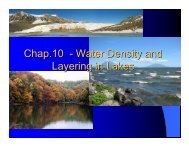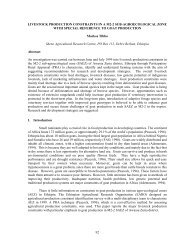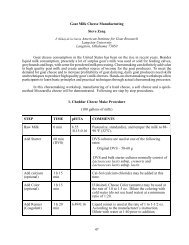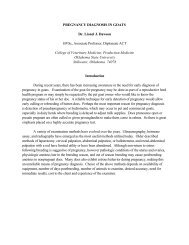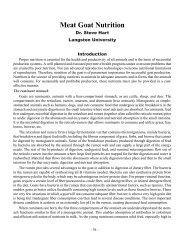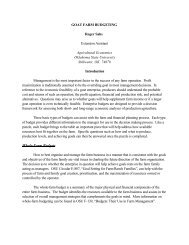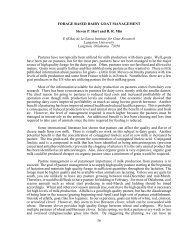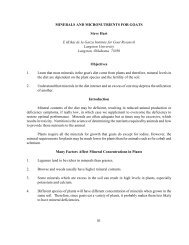chap 2 overview.pdf - Langston University Research and Extension
chap 2 overview.pdf - Langston University Research and Extension
chap 2 overview.pdf - Langston University Research and Extension
You also want an ePaper? Increase the reach of your titles
YUMPU automatically turns print PDFs into web optimized ePapers that Google loves.
Limnologic Overview<br />
Kenneth Williams<br />
Fisheries <strong>Extension</strong> Specialist<br />
<strong>Langston</strong> <strong>University</strong> Aquaculture<br />
<strong>Extension</strong> Program
What is limnology?<br />
A segment of aquatic ecology.<br />
Study of mostly freshwater<br />
environments.<br />
Includes biology, chemistry<br />
<strong>and</strong> physics of aquatic<br />
environments.<br />
Circulation of materials in the<br />
aquatic environment.<br />
Energy flow.
Limnology<br />
Limne – Greek- pool, marsh or lake.<br />
Ology – study of.
Limnology includes:<br />
Lotic habitats – running water.<br />
Lentic habitats – st<strong>and</strong>ing water.<br />
Walden Pond
Where is the water?<br />
97.3% of Earth’s s water is in the oceans.<br />
2.19% is in ice.<br />
About 0.5% is in lakes, rivers, ground<br />
water <strong>and</strong> atmospheric water vapor.
Why is geology important to a<br />
study of limnology?<br />
Chemical composition of the water<br />
depends on geologic sediments in the<br />
watershed – the edaphic factor.
Types of material that affect water<br />
composition<br />
Allochthonous material – substances that<br />
enter a body of water from outside the<br />
stream or lake.<br />
Ex. A leaf from a tree.<br />
Autochthonous material – Substances<br />
derived from within the body of water.<br />
Ex. A dead fish.
Trophic nature of a body of water<br />
Refers to the water’s s soluble nutrients <strong>and</strong><br />
resultant biotic activity.
Trophic nature of a body of water<br />
It is the result of the interaction of at least<br />
3 important factors.<br />
Edaphic factor - Which determines<br />
whether a lake is rich <strong>and</strong> productive or<br />
sterile.<br />
Morphological features – define the<br />
structure of the basin.<br />
Climate – sun, rain, evaporation,<br />
temperature <strong>and</strong> wind are all important.
Lake trophic levels<br />
Lakes all fit on a scale somewhere<br />
between very low productivity <strong>and</strong> low<br />
nutrient level (oligotrophy(<br />
oligotrophy).<br />
And very high productivity <strong>and</strong> rich in<br />
nutrients (eutrophy(<br />
eutrophy).
Physics of water<br />
The water molecule<br />
High specific heat<br />
Density<br />
Currents <strong>and</strong> waves<br />
Temperature<br />
Electronic measurement
Water chemistry<br />
Ionic components of water <strong>and</strong> their effect<br />
on water cycles <strong>and</strong> all life on earth.
Biological components of limnology<br />
Ecological aspects<br />
Community dynamics<br />
Life histories of aquatic plants <strong>and</strong><br />
animals.<br />
Biological productivity.<br />
Photosynthesis.
History<br />
A beginning in 1892. Studies on Lake<br />
Geneva Switzerl<strong>and</strong> by Forel.<br />
Treatise on Limnology, Hutchinson (1957).<br />
Emphasis on st<strong>and</strong>ing water.<br />
Hynes (1970) emphasizes running water.
Rawson’s s diagram
Key factors in the early<br />
development of limnology:<br />
Developments in marine science<br />
• discovery of zoobenthos <strong>and</strong> plankton<br />
[word "plankton", meaning w<strong>and</strong>erer, was first<br />
used by Hensen (1887) to describe suspended<br />
microscopic material]<br />
Development of applied sciences<br />
• such as fisheries <strong>and</strong> water management, as<br />
fisheries progressed from harvest to<br />
management, fish were seen as the end product<br />
of an exchange of matter.
Limnology - present <strong>and</strong> future<br />
• Limnology has progressed from a descriptive to<br />
comparative phase.<br />
– Comparative science seeks to arrange its findings in<br />
an orderly system with three purposes in mind.<br />
First, to gain an overall view.<br />
Second, to facilitate comprehension of the system<br />
– by abstracting what is common to all <strong>and</strong> basing<br />
distinctions on one or a few characteristic factors.<br />
• Third, to build the most natural system possible <strong>and</strong><br />
deduce from it further information (e.g. classification,<br />
modelling).
Limnology - present <strong>and</strong> future<br />
Because of the complexities <strong>and</strong> intricacies of<br />
aquatic ecosystems we can look at single<br />
components of a lake or river across a range of<br />
ecosystems to compare <strong>and</strong> make inferences<br />
regarding processes.<br />
Examples of products using the comparative<br />
method are indices such as the morphoedaphic<br />
index (M.E.I., R. Ryder) <strong>and</strong> proportional stock<br />
density (P.S.D., R. Anderson).<br />
The best science incorporates both<br />
experimentation <strong>and</strong> detailed analyses of<br />
thecomponent parts <strong>and</strong> processes involved.
Limnology - present <strong>and</strong> future<br />
Final Note: It should become apparent<br />
that the advancement of limnological<br />
science is closely tied to technology <strong>and</strong><br />
the general advancement of allied<br />
sciences.
Lake regions
Lake Typology
Oligotrophic lake<br />
Oligotrophic lakes are characterised by low inputs of nutrients, low to<br />
moderate levels of plant production, relatively clear water. Oligotrophic<br />
lakes generally contain small amounts of organisms but many different<br />
species of aquatic plants <strong>and</strong> animals.
Oligotrophic lake
Oligotrophic lake
Eutrophic lakes<br />
High nutrient input, high plant production, murky water,<br />
anoxia, toxicity. Eutrophic lakes are generally thought to<br />
contain a large number of aquatic plants <strong>and</strong> only a few<br />
different animal species
Eutrophic lake
Eutrophic lake
Dystrophic lakes<br />
Bogs –<br />
Acid waters, stained brown, little or no<br />
calcium<br />
Lack of nutrients<br />
Little biomass or diversity
Primary productivity <strong>and</strong> lake<br />
classification<br />
Based on carbon fixation through<br />
photosynthesis<br />
7-25g carbon/sq.m<br />
sq.m/year or less –<br />
oligotrophic<br />
25-75g carbon – mesotrophic<br />
75-250 g carbon eutrophic<br />
350g – 700g carbon- polluted
Primary productivity is based on<br />
photosynthesis<br />
6 CO 2 + 6 H 2 O + solar energy → C 6 H 12 O 6 + 6 O 2
Extreme rates of carbon fixation<br />
Soda lakes – high in sodium bicarbonate<br />
Lake Nakuru, , Kenya, 3.9kg/sq.m
Lake Nakuru, , Kenya, 3.9kg carbon<br />
fixation/sq.m<br />
sq.m/yr
Extremely low rates of carbon<br />
fixation<br />
Antarctic lake – 0.014g/sq.m/day in<br />
summer
Lake sediments<br />
Copropel – a mixture of humus material,<br />
fluffy, brown to yellow, contains dead<br />
microscopic organisms, fecal matter <strong>and</strong><br />
dead plant material
Lake sediments<br />
Sapropel – sediments formed under<br />
prolonged anaerobic conditions. Black<br />
watery, smells of rotten eggs due to<br />
hydrogen sulfide (H 2 S)
Varves – clearly<br />
viewed layers of<br />
sediment deposited<br />
in a lake from<br />
seasonal inflow of<br />
watershed<br />
sediments or other<br />
material such as<br />
seasonal plankton<br />
blooms.<br />
Age of lakes
Age of lakes<br />
Radiocarbon dating now used frequently<br />
Most natural lakes are about 12,000 yrs<br />
old. Why?<br />
Lake Tahoe is one of the 10 oldest lakes<br />
in the world – 2 million yrs. old
Oligotrophic or Eutrophic?<br />
Lake Tahoe
Aquatic ecosystems<br />
Littoral community
Aquatic ecosystems<br />
Plankton community
Benthic<br />
community<br />
Aquatic ecosystems
Aquatic ecosystems<br />
Detritus community
Aquatic ecosystems<br />
Nekton community
Aquatic ecosystems<br />
Groundwater community
The End


